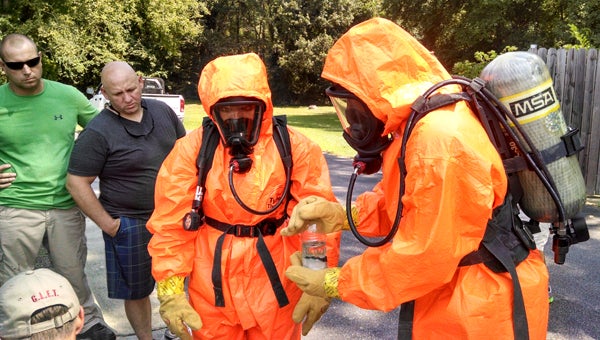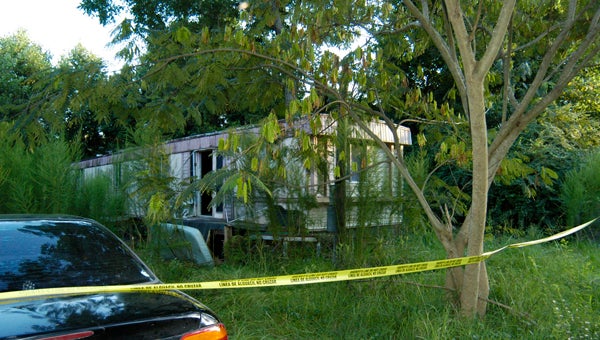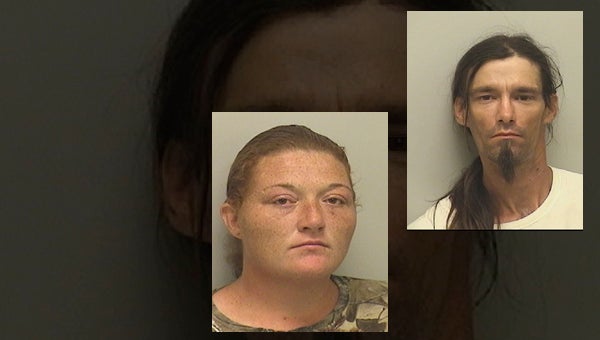BUSTED: Course ups the ante in meth production fight
Published 7:23 pm Saturday, August 30, 2014

CRASH COURSE: Beaufort County Sheriff’s Office Drug Unit Capt. Russell Davenport (left), looks on as course attendees demonstrate handling evidence in methamphetamine production.
Had someone walked into the abandoned trailer on the south side of the Pamlico River, they may never have caught the warning signs: a can of lighter fluid, a few batteries, a bottle of drain cleaner, allergy medicine packaging, an empty two-liter soda bottle — all household items, seemingly randomly discarded. To the unpracticed eye, it’s trash. To those trained to look for something else altogether, they’re the ingredients of methamphetamine, a highly toxic, highly addictive drug. None of the ingredients are illegal to buy, but pairing them together is a dangerous and potentially explosive process.
Last week, members of the Beaufort County Sheriff’s Office Drug Unit attended a NorthFourth Law Enforcement Basic Meth Lab Certification Course, in an effort to curb the growing problem of meth production in Beaufort County. The 40-hour course was recommended to the drug unit by SBI clandestine lab agents because of the number of meth labs found in the county over the past year. Taught by North Carolina SBI agents and Virginia State Police, it was crash course on the dangers of the drug, how it’s produced and the protocol needed to prevent illness or injury when dealing with the extremely volatile mix of chemicals that make meth.

A PLACE TO PRODUCE: Methamphetamine, a highly toxic and addictive drug, was being produced at this abandoned trailer in Aurora. The ingredients used to make meth are common household items, making it difficult for the average person to detect the process.
Until recently, meth labs were few and far between, but in the last year, the drug unit has averaged one meth lab bust a month. Busting meth labs, however, is not as simple as confiscating the drugs and making the arrests. Methamphetamine production is highly toxic. For every one pound of product made, five pounds of toxic waste are produced. The gases released during production are poisonous and can be absorbed into skin, clothing, even the walls of a house. Discovery of a meth lab often looks less a drug bust and more like a toxic waste disaster, where anyone exposed to the drug-making process must be hosed down, their clothes discarded. Agents go into the site wearing Hazmat suits and respirators to avoid breathing in the toxic fumes.
“(The course) taught us how dangerous these things are, but also taught us the proper way to investigate without getting exposed,” said Capt. Russell Davenport, head of the drug unit. “We learned things to look for, for probable cause warrants. We knew a few, but now we know a whole lot more.”
Only 10 SBI agents are assigned to the clandestine lab unit and their jurisdiction is statewide. Because their numbers are so few, law enforcement agencies usually face a wait of hours, if not days, for an SBI response. With the meth lab course behind them, now investigators with the drug unit can assist the clandestine lab unit, as they did Tuesday, when a meth lab was discovered in an abandoned trailer on Dublin Run Road in Aurora.
“We were able to help. We actually went into the lab and helped the SBI dismantle it and it sped up the process,” Davenport said.
 According to a press release from the drug unit, Michael Claude Myers, 36, and Tammy Rana Carawan, 29, both of N.C. Highway 306, Aurora, were using the abandoned single-wide trailer to make meth. Investigators found meth in their vehicle as they were leaving the scene; inside the trailer, they found the ingredients used in the “one-pot” method — Coleman fuel, sodium hydroxide, muriatic acid, lithium batteries and ammonium nitrate, the release said. Myers and Carawan were confined in the Beaufort County Detention Center under no bond. In the case of meth production, suspects can be held without bond as a matter of public safety.
According to a press release from the drug unit, Michael Claude Myers, 36, and Tammy Rana Carawan, 29, both of N.C. Highway 306, Aurora, were using the abandoned single-wide trailer to make meth. Investigators found meth in their vehicle as they were leaving the scene; inside the trailer, they found the ingredients used in the “one-pot” method — Coleman fuel, sodium hydroxide, muriatic acid, lithium batteries and ammonium nitrate, the release said. Myers and Carawan were confined in the Beaufort County Detention Center under no bond. In the case of meth production, suspects can be held without bond as a matter of public safety.
From learning the physical manifestations of meth production and use — extreme tooth decay, bad complexion and hands stained black by exposure to lithium in batteries — to how to decontaminate suspects and prevent diseases like chemical pneumonia through meth lab exposure, the meth lab course has given the drug unit a better education and better tools with which to fight the rising meth incidents in the county, Davenport said.
“We’re hoping the information is out, that we’re just as smart as they are when it comes to making meth — we know what to look for,” Davenport said. “I’m glad the (county) commissioners approved the funding for this and realized that we need to push this problem out of Beaufort County.”




